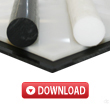As you are perhaps slowly crawling your way along the M1, M6 or the M25 it is quite likely that you are surrounded by various components made of something called polyoxymethylene (POM). But you may also know it as Delrin. Don’t waste your time trying to find it though as you’re driving, but it’s most likely underneath your seat, in your door locks and all sorts of other tucked away places.
What is it really?
It’s actually an Acetal but it’s the ‘homopolymer’ version (homo denoting it’s a single-polymer) It’s also DuPont’s trade name for it. To keep things simple though and less confusing, the industry will usually say Delrin when they mean the homopolymer and Acetal when they mean the co-polymer. Safe to say that by adding a ‘polymer’ to create the co-polymer is a bit of a swings and roundabouts thing, you gain something with one hand and lose something with the other.
A Versatile and Tough Plastic
Delrin, is one of those engineering plastics that does have excellent load-bearing qualities in both tension and compression. Since it doesn’t absorb very much moisture and is resistant to a wide range of solvents, it is great for parts exposed to the elements or harsh industrial environments. It has high yield strength at high heat and offers low friction, high wear resistance and nice and easy to machining.
Some other advantages for the machinist/engineer include:
- Outstanding low temperature performance
- Good electrical and dielectric properties
- High tensile strength
Because Delrin® provides a high degree of stiffness (it’s a bit more rigid) it also outperforms many other engineering plastics on impact resistance this makes it a pretty good choice for the fabricating of thinner and lighter parts. In addition, we’d say that Delrin mates well with metal and other polymers.
Additionally, Delrin combines lubricity (slippyness) and wear resistance along with the stiffness and strength needed in parts that are designed to replace metal. Essentially, Delrin provides a decent balance of properties that actually bridge the gap between metals and plastics.
But Beware the Acids!
Delrin, as we mentioned earlier is an acetal, but despite its excellent resistance to solvents, it’s pretty sensitive to acid attack such as mineral acids and chlorine, and more disappointing is it’s lack of resistance to alkaline oxidation which is made even worse in hot water. This means that even low levels of chlorine in potable water supplies can be enough to cause stress corrosion cracking to develop. It’s turned out to be a real problem which has been experienced in domestic and commercial water supply systems in both the USA and Europe. (this area is an application for Acetal co-polymer)
A few other disadvantages of Delrin include:
- Not a suitable choice for food storage as it is easily attacked by acidic foods.
- Is not readily available in a flame-retardant grade
- Typically very difficult to bond
Difficult Bonding Creates a Bit of a Sticky Wicket
One advantage we noted earlier in that it’s got good solvent resistance, but the downside of this though is that it’s very difficult to bond. Over the years, a number of processes and treatments have been developed to improve bonding, although typically these processes involve surface etching, flame surface treatment or mechanical abrasion. The etching processes usually involve chromic acid at raised temperatures. The good news is that once the surface is prepared, there should be a number of adhesives available to bond it from an adhesive expert company.
These include epoxies, cyanoacrylates and polyurethanes. Cyanoacrylates are useful for bonding to metal, leather, rubber and other plastics. Remember solvent welding is
All the Things You Can Do With Delrin!
A typical application for Delrin would often include those automotive and consumer electronics items.
So, where to use it? Well any application which needs lighter, lower-cost and corrosion-resistant components. Its low-friction properties make it an ideal material for improving the speed at which high-adhesion foods can be fed through the food processor.
Delrin really is a versatile plastic that finds applications in a wide variety of industries such as:
- Electrical Engineering: insulators, bobbins, connectors and parts for electronic devices
- Vehicle: Fuel sender units, lights, power window components and door lock systems,
- Medical: insulin pens and metered dose inhalers
- Furniture: hardware, locks, handles and hinges.
- Construction: Structural Glass
- Packaging: aerosol cans and vehicle tanks.
But what’s It Like to Work with You Might Ask?
One of the most common forms of Delrin is rod/bar which is machined by turning, milling, drilling and so on. You could definitely call this a free-cutting material, as always it does require sharp tools with a high clearance angle but it ‘chips’ rather than comes off in a ‘string’ it also leaves a superb finish so it’s a dream to machine. As with all plastics, you should always use soluble cutting fluid or water to keep the heat down although it’s not absolutely critical to lubricate when cutting. Unlike most metals, we should probably use slightly less clamping force and a bit more support for the work piece since Delrin lacks the same degree of rigidity as steels.
Bit of a no-brainer here but If you’re anticipating designing large parts with Delrin, it’s recommended that these be designed with added fillets or strengthening ribs. Also, annealing pre-machined parts before the final finishing phase is a nice alternative. In general, however, small components machined with Delrin don’t suffer much from warping.
So, in conclusion:
Delrin is an engineering thermoplastic that can be used for creating great precision parts requiring decent stiffness, low friction and excellent dimensional stability. From auto parts to innovative new medical devices, Delrin is a good choice for consumer and industrial solutions, it’s really easy to machine and is pretty tough










